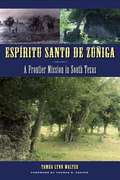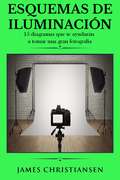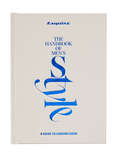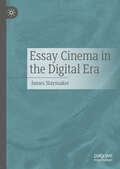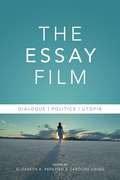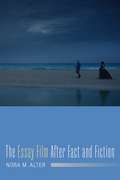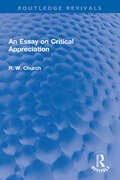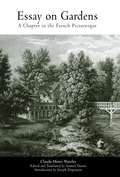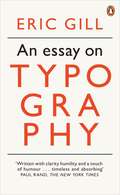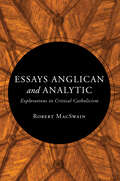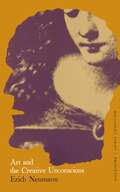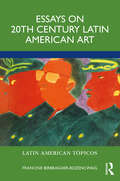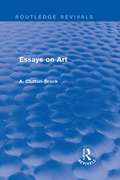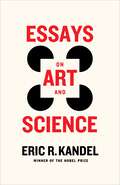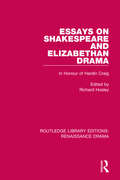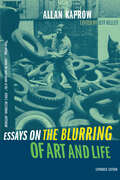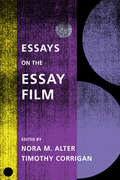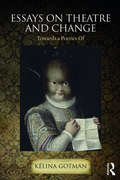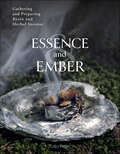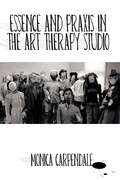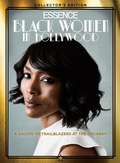- Table View
- List View
Espíritu Santo de Zúñiga: A Frontier Mission in South Texas
by Tamra Lynn WalterWalter goes beyond simple descriptions of artifacts and mission architecture to address the role these elements played in the lives of the mission residents, demonstrating how archaeology is able to address issues that are not typically addressed by historians. In doing so, she presents an accurate portrait of life in South Texas at this time. This study of Mission Espíritu Santo will serve as a model for research at similar early colonial sites in Texas and elsewhere.
Esquemas de Iluminación: 15 diagramas que te ayudarán a tomar una gran fotografía
by James Christiansen¿Cansado de fotografías que salen muy oscuras, muy claras o no del todo “bien”? ¡Mis esquemas de iluminación te ayudarán a hacer mejores fotografías con una iluminación óptima desde hoy! En última instancia, hacer grandes fotografías, sobre todo con los increíbles avances tecnológicos actuales en cámaras, no es tan complicado. Uno de los conceptos fundamentales que tienes que comprender es cómo ajustar la luz correctamente para una foto, y este libro te enseñará cómo hacerlo exactamente con esquemas de iluminación fáciles de seguir. Este libro cubrirá esquemas de iluminación para: •Retratos de bebés •Retratos individuales •Retratos familiares •Rostros •Fotos de mascotas •Fotos de productos (¡estupendos para eBay o Craiglist!) •Siluetas Y mucho, mucho más, ¡incluyendo aún más diagramas y recomendaciones de equipamiento! ¡Deja de tomar fotos malas y empieza a tomar grandes fotos con estos sencillos esquemas de iluminación!
Esquire The Handbook of Men's Style: A Guide to Looking Good
by Esquire Michael B. DoughertyA completely revised edition of the essential manual for dressing—and feeling—your very best, featuring Esquire's signature wit and humor and 200+ photos and illustrationsExpert menswear and grooming advice for young and experienced professionals—from building a wardrobe and discerning clothing quality to self-expression through fashionStyle is a way of speaking to the world. Like it or not, what you wear and how you wear it matters. In this best-selling guide from the editors of Esquire, you&’ll learn how to hone your personal style—and even have some fun while you&’re at it.In this pocket-sized handbook, style-minded individuals will find expert advice on how to:Buy suits and other formal wear for their immediate and long-term needs Navigate an increasingly dressed-down world while still looking your absolute bestAccessorize and style your clothes to level up your outfitsChoose the right clothes for all shapes and sizes and how to make grooming choices to look your best Play with previously gendered pieces like pearl necklaces and embrace genderless dressing trendsDefine menswears trends like Gorpcore, Normcore and Stealth Wealth and decide if they are worth investing in Determine quality and identify different fabrics and materialsCare for you clothes so they last Build a wardrobe and signature style with foundational pieces (a white tee is a must) and standout pieces you loveThroughout readers will find style icons—including classics like Frank Sinatra and George Clooney, and new tastemakers like Donald Glover, Travis Kelce, Yahya Abdul-Mateen II, Harry Styles, and ASAP Rocky—who demonstrate great taste and original personal expression.Visually bold with hundreds of photos and illustrations, this sophisticated reference book is the ideal gift for fashion enthusiasts.
Essay Cinema in the Digital Era
by James SlaymakerThis book explores the impact of digital technology on the essay film in the early 21st century, arguing that the cinematic essay has been associated with technological evolution throughout its history. The author considers the output of four towering figures in essay filmmaking: Harun Farocki, Chris Marker, Chantal Akerman and Jean-Luc Godard, and explores the ways in which these directors utilise aesthetic strategies, editing techniques, and modes of spectatorial address that are rooted in the capabilities of digital technologies. Slaymaker conceptualises the cinematic essay as a self-reflexive mode of nonfiction cinema—one that foregrounds the filmmaking apparatus and the act of its own making, and which thereby launches an inquiry into the ontological nature of the cinematic image, the tools which construct it, and the wider artistic landscape in which it is embedded.
The Essay Film: Dialogue, Politics, Utopia
by Caroline Eades Elizabeth PapazianWith its increasing presence in a continuously evolving media environment, the essay film as a visual form raises new questions about the construction of the subject, its relationship to the world, and the aesthetic possibilities of cinema. In this volume, authors specializing in various national cinemas (Cuban, French, German, Israeli, Italian, Lebanese, Polish, Russian, American) and critical approaches (historical, aesthetic, postcolonial, feminist, philosophical) explore the essay film and its consequences for the theory of cinema while building on and challenging existing theories. Taking as a guiding principle the essay form's dialogic, fluid nature, the volume examines the potential of the essayistic to question, investigate, and reflect on all forms of cinema-fiction film, popular cinema, and documentary, video installation, and digital essay.A wide range of filmmakers are covered, from Dziga Vertov (Man with a Movie Camera, 1928), Chris Marker (Description of a Struggle, 1960), Nicolás Guillén Landrián (Coffea Arábiga, 1968), Pier Paolo Pasolini (Notes for an African Oresteia, 1969), Chantal Akerman (News from Home, 1976) and Jean-Luc Godard (Notre musique, 2004) to Nanni Moretti (Palombella Rossa, 1989), Mohammed Soueid (Civil War, 2002), Claire Denis (L'Intrus, 2004) and Terrence Malick (The Tree of Life, 2011), among others. The volume argues that the essayistic in film-as process, as experience, as experiment-opens the road to key issues faced by the individual in relation to the collective, but can also lead to its own subversion, as a form of dialectical thought that gravitates towards crisis.
The Essay Film: Dialogue, Politics, Utopia (Nonfictions)
by Papazian Elizabeth Eades CarolineWith its increasing presence in a continuously evolving media environment, the essay film as a visual form raises new questions about the construction of the subject, its relationship to the world, and the aesthetic possibilities of cinema. In this volume, authors specializing in various national cinemas (Cuban, French, German, Israeli, Italian, Lebanese, Polish, Russian, American) and critical approaches (historical, aesthetic, postcolonial, feminist, philosophical) explore the essay film and its consequences for the theory of cinema while building on and challenging existing theories. Taking as a guiding principle the essay form's dialogic, fluid nature, the volume examines the potential of the essayistic to question, investigate, and reflect on all forms of cinema—fiction film, popular cinema, and documentary, video installation, and digital essay.A wide range of filmmakers are covered, from Dziga Vertov (Man with a Movie Camera, 1928), Chris Marker (Description of a Struggle, 1960), Nicolás Guillén Landrián (Coffea Arábiga, 1968), Pier Paolo Pasolini (Notes for an African Oresteia, 1969), Chantal Akerman (News from Home, 1976) and Jean-Luc Godard (Notre musique, 2004) to Nanni Moretti (Palombella Rossa, 1989), Mohammed Soueid (Civil War, 2002), Claire Denis (L'Intrus, 2004) and Terrence Malick (The Tree of Life, 2011), among others. The volume argues that the essayistic in film—as process, as experience, as experiment—opens the road to key issues faced by the individual in relation to the collective, but can also lead to its own subversion, as a form of dialectical thought that gravitates towards crisis.
The Essay Film After Fact and Fiction (Film and Culture Series)
by Nora M. AlterNora M. Alter reveals the essay film to be a hybrid genre that fuses the categories of feature, art, and documentary film. Like its literary predecessor, the essay film draws on a variety of forms and approaches; in the process, it fundamentally alters the shape of cinema. The Essay Film After Fact and Fiction locates the genre’s origins in early silent cinema and follows its transformation with the advent of sound, its legitimation in the postwar period, and its multifaceted development at the turn of the millennium. In addition to exploring the broader history of the essay film, Alter addresses the innovative ways contemporary artists such as Martha Rosler, Isaac Julien, Harun Farocki, John Akomfrah, and Hito Steyerl have taken up the essay film in their work.
An Essay on Critical Appreciation (Routledge Revivals)
by Ralph W. Church dec'dFirst published in 1938, An Essay on Critical Appreciation aims to provide a language suited for the explication on beauty. This explication is not based merely on emotion but is motivated by contemplation and discrimination. By virtue of being rendered in a discourse, an appreciation can claim to be critical or discriminating and ‘beauty’ can be said to have characteristics. The search of such a language takes the author through the contemplation on the meaning of ‘beauty’, entertaining contrary views, and reaching at an understanding of the aesthetic situation. This book will be of interest to students of English literature, philosophy and art.
Essay on Gardens
by Claude-Henri Watelet Samuel Danon Joseph DisponzioPublished in 1774, Essay on Gardens is one of the earliest texts showing the progressive shift in French taste from the classical model of the gardens at Versailles to the picturesque or natural style of garden design in the late eighteenth century. In this formulation of his ideas concerning landscape, Claude-Henri Watelet describes an ideal farm and also his own very real garden, Moulin Joli, near Paris. He advances the theory that the useful and the pleasurable must be combined in the planning, preservation, and decoration of the land by offering a relatively novel design that uses experimental methods to create a comfortable estate. The result is a horticultural and ecological laboratory that includes a residence, a farm, stables, a dairy, an apiary, a mill, walks, vistas, flower beds, an area reserved for medicinal plants, decorative statues, a medical laboratory, and even a small infirmary for ailing members of the community.Given the wide scholarly interest in the field of garden design and its history, this first English edition of Watelet's small but influential book will interest historians of landscape design as well as students of the history of architecture. Joseph Disponzio's informative introduction to Samuel Danon's masterful translation situates the Essay on Gardens within the framework of other landscape and garden treatises of the late eighteenth century. Although the original text was not illustrated, this edition includes a selection of charming drawings and etchings of Moulin Joli by Watelet himself, Hubert Robert, and others.
An Essay on Typography (Penguin Modern Classics)
by Eric GillEric Gill's opinionated manifesto on typography argues that 'a good piece of lettering is as beautiful a thing to see as any sculpture or painted picture'. This essay explores the place of typography in culture and is also a moral treatise celebrating the role of craftsmanship in an industrial age. Gill, a sculptor, engraver, printmaker and creator of many classic typefaces that can be seen around us today, fused art, history and polemic in a visionary work which has been hugely influential on modern graphic design.'Written with clarity, humility and a touch of humour . . . timeless and absorbing' Paul Rand, The New York Times'His lettering was clear, confident and hugely influential on the development of modern type design. The world has now caught up with Gill' GuardianHow do we see the world around us? This is one of a number of pivotal works by creative thinkers like John Berger and Susan Sontag whose writings on art, design and the media have changed our vision for ever.
Essays Anglican and Analytic: Explorations in Critical Catholicism
by Robert MacSwainExplore the riches at the intersection of Anglican and philosophical theology. In this thought-provoking essay collection, Robert MacSwain explores important connections between Anglican and philosophical theology. Shining a spotlight on the underappreciated theological work of Austin Farrer and David Brown, he brings them into creative conversation with better-known figures such as Joseph Butler, C. S. Lewis, Stanley Hauerwas, and Eleonore Stump. He skillfully leads readers through diverse conceptual territory ranging from the Reformed epistemology of Alvin Plantinga and Nicholas Wolterstorff, to the hiddenness argument of J. L. Schellenberg, to a sacramental vision of human culture and the arts. More broadly, MacSwain outlines what he calls &“Critical Catholicism,&” explaining how it differs from other movements in contemporary Christian thought such as Radical Orthodoxy and Analytic Theology. These perceptive essays will be of particular interest to scholars and pastors who are curious about connections between theology, philosophy, and Anglican studies.
The Essays of Erich Neumann, Volume 1: Art and the Creative Unconscious (Works by Erich Neumann #23)
by Erich NeumannFour essays on the psychological aspects of art. A study of Leonardo treats the work of art, and art itself, not as ends in themselves, but rather as instruments of the artist's inner situation. Two other essays discuss the relation of art to its epoch and specifically the relation of modern art to our own time. An essay on Chagall views this artist in the context of the problems explored in the other studies.
Essays on 20th Century Latin American Art (Latin American Tópicos)
by Francine Birbragher-RozencwaigEssays on 20th Century Latin American Art provides a broad synthesis of the subject through short chapters illustrated with reproductions of iconic works by artists who have made significant contributions to art and society. Designed as a teaching tool for non-art historians, the book's purpose is to introduce these important artists within a new scholarly context and recognize their accomplishments with those of others beyond the Americas and the Caribbean. The publication provides an in-depth analysis of topics such as political issues in Latin American art and art and popular culture, introducing views on artists and art-related issues that have rarely been addressed. Organized both regionally and thematically, it takes a unique approach to the exploration of art in the Americas, beginning with discussions of Modernism and Abstraction, followed by a chapter on art and politics from the 1960s to the 1980s. The author covers Spanish-speaking Central America and the Caribbean, regions not usually addressed in Latin American art history surveys. The chapter on Carnival as an expression of popular culture is a particularly valuable addition. This book will be of interest to students and scholars of Latin American history, culture, art, international relations, gender studies, and sociology, as well as Caribbean studies.
Essays on Art (Routledge Revivals)
by A. Clutton-BrockThis collection of brief but insightful essays, though always returning to the author’s central conviction that the quality of artistic endeavour depends not on individuals of genius but on the attitude of the public towards art itself, examines a wide variety of unique but related issues: the relationship between natural and artistic beauty; the genius of Da Vinci and Nicholas Poussin; the influence of femininity on European art; the importance of good criticism; art as a social phenomenon; the role of the passions; and a range of associated topics. First published in 1919, A. Clutton-Brock’s reflections on the nature and function of art bear the marks of the deep anxieties following the First World War, and can thus speak to a generation similarly faced with uncertainty.
Essays on Art and Science
by Eric R. KandelWhen we view a work of art, we often experience an emotional response, but the causes of our reactions are complex. Our knowledge of why we respond to art as we do is rooted in science—in psychology and biology. Eric R. Kandel traces the origins of this understanding to early twentieth-century Vienna, which gave rise to the concept of the “beholder’s share,” the realization that art is incomplete without the perceptual and emotional involvement of the viewer—that is, without our responses to it.But what causes our response? Our brain is a creativity machine that brings to bear on any image—including a painting—certain innate, universal processes related to sensory perception as well as higher-order processes related to our personal experiences, memories, and emotions. Understanding how these unconscious processes in the brain interact to create the beholder’s share is one of the great challenges currently confronting brain science.The essays on art and science in this book vary widely in subject matter, including the angst-ridden portraits of Soutine, conflicting views of women’s sexuality, Cubism’s challenge to our innate visual processes, and why we react differently to abstract versus figurative art. But each essay focuses on the interaction of art and science. Woven throughout are the many notable scientists, art historians, artists, and others, both Jewish and non-Jewish, who contributed to our understanding of how we experience art.
Essays on Shakespeare and Elizabethan Drama: In Honour of Hardin Craig (Routledge Library Editions: Renaissance Drama #Vol. 5)
by Richard HosleyThe twenty-eight essays of this collection, first published in 1962, are the work of distinguished British, Canadian, and American scholars. The essays range widely over the field of Elizabethan drama, concentrating attention on Shakespeare and Marlowe but not neglecting earlier dramatists such as Kyd and Greene or later ones such as Heywood and Massinger. Among the general topics treated are the staging of the interludes, intrigue in Elizabethan tragedy, and Jacobean stage pastoralism. This title will be of interest to students of English literature.
Essays on the Blurring of Art and Life: Expanded Edition
by Allan KaprowAllan Kaprow's "happenings" and "environments" were the precursors to contemporary performance art, and his essays are some of the most thoughtful, provocative, and influential of his generation. His sustained inquiry into the paradoxical relationship of art to life and into the nature of meaning itself is brought into focus in this newly expanded collection of his most significant writings. A new preface and two new additional essays published in the 1990s bring this valuable collection up to date.
Essays on the Essay Film (Film and Culture Series)
by Alter Nora M. Corrigan TimothyThe essay—with its emphasis on the provisional and explorative rather than on definitive statements—has evolved from its literary beginnings and is now found in all mediums, including film. Today, the essay film is, arguably, one of the most widely acclaimed and critically discussed forms of filmmaking around the world, with practitioners such as Chris Marker, Hito Steyerl, Errol Morris, Trinh T. Minh-ha, and Rithy Panh. Characteristics of the essay film include the blending of fact and fiction, the mixing of art- and documentary-film styles, the foregrounding of subjective points of view, a concentration on public life, a tension between acoustic and visual discourses, and a dialogic encounter with audiences.This anthology of fundamental statements on the essay film offers a range of crucial historical and philosophical perspectives. It provides early critical articulations of the essay film as it evolved through the 1950s and 1960s, key contemporary scholarly essays, and a selection of writings by essay filmmakers. It features texts on the foundations of the essay film by writers such as Hans Richter and André Bazin; contemporary positions by, among others, Phillip Lopate and Michael Renov; and original essays by filmmakers themselves, including Laura Mulvey and Isaac Julien.
Essays on Theatre and Change: Towards a Poetics Of
by Kélina GotmanIf theatre is a way of seeing, an event onstage but also a fleeting series of moments; not a copy or double but more vitally metamorphosis, transformation, and change, how might we speak to – and of – it? How do we envision and frame a fluid reality that moves faster than we can write? Arranged over two parts, 'Figurations' and 'Translations', Essays on Theatre and Change reflects on the animal, history, doubling, translation, and the performative potential of writing itself. Each fictocritical essay weaves between voices, genres and contexts to consider what theatre might be, offering a 'partial object' rather than a complete theory. Leaving the page radically open to its reader, Essays on Theatre and Change is a dazzling, multi-lensed account of what it is to think and write on theatre.
Essence and Ember: Gathering and Preparing Herbal, Resin, and Wood Incense
by Katja PetersPhotographed guide to crafting incense with herbs, wood, and resin. This meticulously crafted guide delves into the rich history of incense burning, offering insights into the use of herbs, resins, and woods to find inner peace and connect with nature. Key Features: Holistic Approach: Discover the holistic approach to incense, connecting with nature and finding peace in today's fast-paced world. Diverse Ingredients: Explore a wide array of incense ingredients, including herbs, resins, and woods, emphasizing sustainable and ethical consumption. Responsible Harvesting: Learn responsible gathering practices, including the 1:10 collection rule and considerations for protected herbs. Practical Techniques: Gain practical insights into drying and preserving herbs, resins, and woods, ensuring optimal quality for incense preparation. Transformative Power: Understand the transformative potential of incense, offering a sensory journey that transcends time and tradition. Unveil the secrets of incense preparation, blending ancient wisdom with modern relevance. Essence and Ember guides the reader on a transformative journey, deepening one's connection with nature's fragrant treasures.
Essence And Praxis In The Art Therapy Studio
by Monica CarpendaleEssence and Praxis in the Art Therapy Studio introduces the theory and practice of Art Therapy. A phenomenological approach to art therapy is presented that includes metaphor theory, social constructivism, hermeneutics, eco psychology, earth art, psychoanalysis, object relations theory, humanistic and gestalt therapy. In the book, theory and practice reflect each other as it focuses on the creative process, dialogue and interpretation, and provides a number of exercises and art activities that can be used in a therapeutic context. The role of symbolic interpretation is explored within the context of art therapy. The essence and attitude of the art therapist and the importance of therapeutic presence is presented with a series of self-reflective questions and exercises. In summary, this book is an introductory studio manual for training Art Therapists, and it emphasizes the ongoing relationship between theory and practice.
ESSENCE Black Women in Hollywood: A Salute to Trailblazers at the Oscars
by The Editors of EssenceThe bold and the beautifulFrom the moment that Hattie McDaniel won Best Supporting Actress for her portrayal of Mammy in Gone With the Wind (1939), a new course for African American women in Hollywood was set. Though, for this great achievement, it would be 63 years before another African American woman-Halle Berry-would claim the trophy for Best Actress. Black Women in Hollywood: A Salute to Trailblazers at the Oscars, the new Collector's Edition from ESSENCE, is a visual chronicle of the strides that African American actresses have made in Hollywood. From the early pioneers like Ethel Waters and Juanita Moore to the leading lights of the 70s and 80s, such as Cicely Tyson, Diahann Carroll and Diana Ross, and to the stars that rock the red carpet today, including Taraji P. Henson, Lupita Nyong'o and Viola Davis. We feature the nominees and the winners on-set, on the red carpet and in their own words-including the inspiring acceptance speeches of each of the winners. And of course, the photographs: dozens of pictures showcasing these trailblazers on the red carpet, in the roles that won them nominations, and even relaxing at home. Black Women in Hollywood is both a walk down memory lane and an inspirational reminder: to dream bigger than you could have ever imagined.
